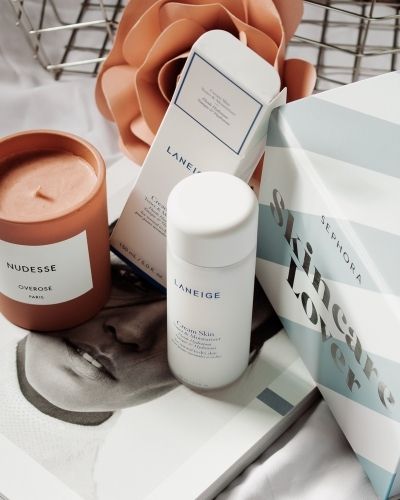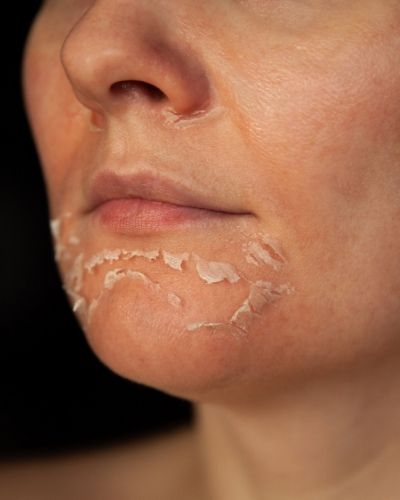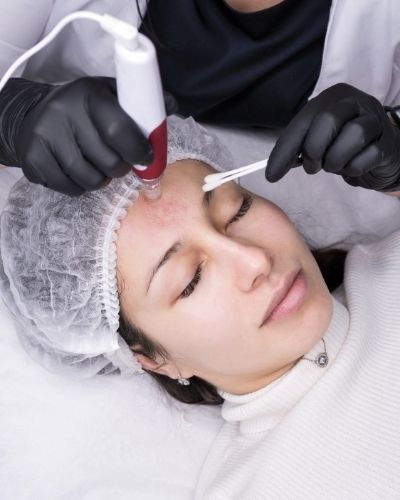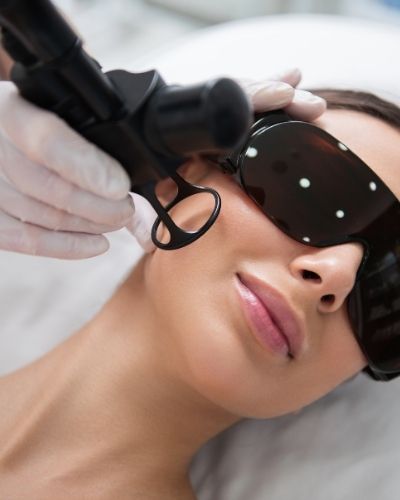When acne is finally gone, many of us are left dealing with the consequences this inflammatory condition left on our skin.
These consequences may appear in the form of hyperpigmentation, uneven skin tone, post-inflammatory redness, uneven texture, bumpy skin, pitted scarring, etc.
Luckily, most of the damage left from acne is treatable; however, it goes without saying that you will need a lot of patience, use of the right treatments, some professional help, and most importantly – you need to be extra caring towards your skin.
Which is why, in this article, I will give you three ways on how to repair skin damage from acne through the help of a good skincare routine, along with suggestions on which professional treatments you should look into.

Create a Good Skincare Routine

Works for:
- All skin types
- All skin concerns
How to create a good skincare routine?
A good skincare routine will not only help repair skin damage from acne but will also nourish, improve, and protect your skin and prevent further damage from occurring.
To create a good skincare routine, you need to start by addressing your particular skin needs and skin concerns and sticking to the simplest, most minimal list of products that work.
Start by introducing the following products into your routine:
A gentle cleanser that you can use in the evening to remove makeup, grime, excess oils, and dirt from your skin before going to bed and in the morning if you need to remove excess oils and sweat.
Make sure to choose an adequate cleanser for your skin needs and skin concern.
Avoid using harsh cleansers that will dry out your skin and give you a squeaky clean and tight feeling after using it. This may make you think your skin is clean, but it is actually dehydrated and will eventually start to show signs of irritation.
Opt for cleansers that are gentle and hydrating, such as some of these that you can find in my latest article on products for acne-prone and sensitive skin.
A treatment that contains an active ingredient that will help you target your main skin concern. The best acne treatments are retinoids, benzoyl peroxide, salicylic acid, or mandelic acid.
Retinoids and mandelic acid will not only help you keep future breakouts at bay but will also address skin damage left from acne, such as hyperpigmentation, uneven skin tone, and texture.
Salicylic acid and benzoyl peroxide, on the other hand, have a more straight-to-the-point function to keep future breakouts at bay by clearing out the pores from deep within.
A moisturizer that will help slow down trans-epidermal water-loss and will soften the skin.
You may also opt for moisturizers that contain some milder actives such as niacinamide or ceramides to help brighten the skin and strengthen the skin barrier.
Sunscreen is the most important weapon in your arsenal, especially when you use products that are working to get rid of the damage left from acne.
You don’t want the UV rays setting all that progress back to zero and creating more inflammation that will lead to more severe hyperpigmentation, redness, and uneven skin tone.
Take your sunscreen application game seriously, or else everything you do for your skin will be useless.
Look Into Professional Treatments
Professional treatments are not the cheapest option; however, they are the most efficient when it comes to eliminating skin damage left from acne.
Treatments such as chemical peels, microneedling, or laser therapy will give you a dramatic improvement after only one session, but it usually takes 3-4 (depending on what your esthetician or dermatologist suggests) to fully get rid of whatever skin damage you may be dealing with.
What’s also great about doing professional treatments are the permanent results.
Once you are done with the initial number of sessions, it’s entirely up to you whether you want to get another 1-2 sessions a year purely for maintenance purposes, but you likely won’t have to if you have a good skincare routine that works for your skin and doesn’t cause inflammation.
So, here are a few options of professional treatments for getting rid of skin damage:
Chemical peels

Works best for:
- Active acne
- Hyperpigmentation
- Uneven skin tone/dullness
- Bumps and texture
- Superficial (expression) lines
Not ideal for:
- Post-inflammatory erythema (redness)
- Pitted acne scarring
- Moderate/deep wrinkles
Chemical peels are one of my favorite professional treatment that addresses many skin concerns at once.
These are a special blend of usually more than one hydroxy acid that work at a very low pH to remove layers and layers of dead skin cells that are causing congestion, dullness, texture, etc.
Once applied to the skin, a process known as frosting will start occurring after a couple of minutes, and this is when parts of your skin will turn white and eventually shed for a few days after the treatment.
A few days after the chemical peel, your skin will feel raw as it starts to darken and shed, slowly revealing a regenerated layer of new skin that’s smooth, bright, and glowy.
It’s important to do chemical peels to address the right concerns; otherwise, it could potentially be a waste of money if, for example, you want to treat deep, pitted scarring.
Be realistic with your expectations and make sure that what you want to achieve with your skin is achievable with a chemical peel as, although very efficient, these solutions can’t treat every skin concern you can think of.
Here are a few things to avoid doing at least 7 days (or more) before doing a chemical peel:
- Excessive exfoliation (stop exfoliating 5-7 days before chemical peels).
- Usage of prescription retinoids (tretinoin, tazarotene).
- Accutane (if you are taking this medication, you won’t be able to do a chemical peel).
- Tanning and/or excessive sun exposure without adequate protection (high SPF or a hat).
- Microneedling sessions.
- Laser treatments.
Chemical peels are also a treatment that can be done 1-2 times a year for maintenance purposes, rejuvenation, anti-aging, congestion, acne, etc.
Light peels can cost as low as $150, and deep peels can cost $3,000 or more (specifically if it requires anesthesia or in-patient stays).
According to the American Society of Plastic Surgeons, the current average cost of a chemical peel in the US is $673.
In lower-income countries in Europe, the price for a chemical peel starts at €60+, while in high-income countries like Scandinavia, the starting price point is €170+.
Microneedling

Works best for:
- Pitted acne scarring
- Skin texture
- Fine lines
- Moderate-depth wrinkles
Not ideal for:
- Post-inflammatory erythema (redness)
- Hyperpigmentation
- Rosacea
- Active acne
Also known as collagen induction therapy, microneedling uses either a fine-needle roller or pen device to create tiny holes in the top layer of the skin.
The procedure stimulates collagen production, which helps improve fine lines, moderate wrinkles, skin texture, and pitted acne scarring.
Depending on the depth of the scar, the resilience of your skin, and at-home maintenance, you may need anywhere from 3-5 microneedling sessions to see dramatic results, but most people usually see a satisfying difference after the very first treatment.
A few things to avoid at least 7 days (or more) before and after a microneedling treatment:
- Chemical peels.
- Excessive exfoliation (stop exfoliating 5-7 days before microneedling).
- Usage of prescription retinoids (tretinoin, tazarotene).
- Tanning and/or excessive sun exposure without adequate protection (high SPF or a hat).
- Laser treatments.
A professional microneedling session will typically cost you anywhere from $200 up to $700, depending on where you are in the US.
In lower-income countries in Europe, microneedling typically goes from €70+, while in high-income countries such as Scandinavia, the starting price point can be at €160.
***Before booking, make sure to check whether the esthetician will be using a pen or a roller to perform the procedure. Always opt for a pen because the roller is an older method that can be more damaging to the skin.
Laser

Works best for:
- Post-inflammatory erythema (redness)
- Hyperpigmentation
- Uneven skin tone
- Pitted or raised scars
- Superficial/moderate/deep wrinkles
Not ideal for:
Lasers work to address virtually any skin concern under the sun, but given that the treatments are quite expensive, other options are more cost-friendly for specific concerns such as active acne, for example.
Doctors often use fractional or carbon dioxide ablative lasers to treat acne scars, including hyperpigmentation, post-inflammatory redness, and pitted scarring.
A doctor will apply a numbing cream on the areas you are going to treat roughly 30 minutes before the procedure to ensure no discomfort is felt.
However, the skin will be swollen and red for a few days after the treatment. Bleeding also occurs very frequently and can last for up to five days.
During the downtime while your skin is healing, you won’t be able to apply any type of cosmetics, and your doctor will advise you on how to ensure the treated area remains clean at all times.
Laser treatments are the most efficient treatment for repairing skin damage from acne, and although most people see dramatic changes after only one treatment, you may still need 2-3 sessions for best results.
A few things to avoid at least 15 days before and after laser treatment are:
- Chemical peels.
- Microneedling.
- Exfoliation.
- Usage of prescription retinoids (tretinoin, tazarotene).
- Accutane (you will likely be asked to finish your course of taking the medication before you can do a laser treatment).
- Tanning and/or sun exposure without adequate protection (high SPF or a hat).
Laser treatments are quite expensive and can go anywhere from $900 to $1600+ per treatment in the US.
The prices here in Europe start anywhere from €300 and can go all the way up in the thousands per session, depending on your location and the number of sessions you will need.
Avoid Causing Inflammation To Your Skin
This is one of the most important things you should do so that you won’t have to deal with more inflammation, more acne, and more damage caused by these two factors.
The few best things you should do to avoid causing inflammation to your skin are:
- Have a good skincare routine.
- Visit your esthetician for professional treatments as maintenance once a year.
- Avoid sun exposure.
- Use sunscreen even on cloudy days.
- Avoid smoking, as this will take a toll on your skin over time.
- Have a good diet that consists of antioxidant foods and healthy fats.
- Avoid consuming too much sugar.
- Avoid drinking too much coffee and replace it with green tea instead.
- Watch your dairy intake.
- Hydrate your body by drinking water, as this will help you avoid constipation (which, believe it or not, shows on the skin).
- Don’t stress. Stress affects the skin big times!
And lastly but most importantly, whenever your skin starts acting up – seek professional help immediately.
You shouldn’t stress over a single pimple here and there or a breakout that goes away after your period ends, but also don’t allow that breakout to become severe to the point where you will have to deal with both acne and scarring.
If you feel like something is not right, or your skincare routine isn’t working as it should, you may need a tweak here and there, which is why it’s good to immediately contact your esthetician or dermatologist and see it through before the issue becomes more serious.
By acting fast, you will prevent the inflammation from spreading and leaving damage that’s both difficult and expensive to repair.
RELATED: Tips On How To Save Money & Get Clear Skin

My name is Simone and I am a certified skin specialist. I created this website to teach my readers how to take great care of their skin and I also like to occasionally share my honest opinions on skincare products I’ve tried. You can learn more about me here.
